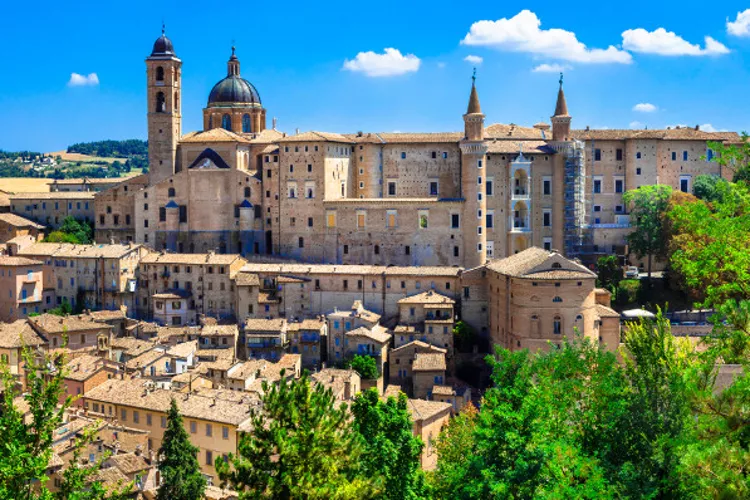Urbino, nestled in the heart of the Montefeltro region, is one of the most charming and historic cities in the Marche. This area, which stretches between the Marche, Romagna, and San Marino, is famous for its breathtaking landscapes, rich history, and its role as a key center during the Italian Renaissance. Once the capital of one of the most powerful duchies of the era, Urbino today stands as a prominent cultural and tourist destination, attracting visitors from all over the world.
In 1998, its historic center was recognized by UNESCO as a World Heritage site, a testament to its architectural and artistic significance. The medieval streets, Renaissance palaces, and charming squares make Urbino a must-visit destination for those wishing to immerse themselves in Italy’s vibrant history and culture.
What to See in Urbino: A Journey Through the Renaissance
The most iconic symbol of Urbino is undoubtedly the Palazzo Ducale (Ducal Palace), one of the most beautiful Renaissance residences in Italy. With its impressive facade and richly decorated interiors, the palace was the home of the Dukes of Urbino, particularly Federico da Montefeltro, one of the greatest military leaders and patrons of the arts. Inside, the Museo Nazionale delle Marche (National Museum of the Marche) houses a vast collection of artworks, including masterpieces by artists like Piero della Francesca, Raphael, and Titian.
Just steps from the Ducal Palace, visitors can find the Casa Natale di Raffaello (Birthplace of Raphael), the birthplace of one of the greatest painters in history and an icon of Urbino. The house, now a museum, offers an accurate display of his early works and his first steps in the world of art. Urbino’s connection to Raphael is deeply rooted, as the city remains a symbol of his artistic legacy.
No visit to Urbino is complete without exploring the Duomo di Urbino (Cathedral of Urbino), a majestic church that, although it has undergone various changes over the centuries, still holds a sacred and powerful presence in the city. The crypts beneath the cathedral provide an intriguing experience of historical exploration, where the past and mystery blend together.
Other unmissable sites include the Chiesa di San Francesco (Church of St. Francis), known for its beautiful frescoes, and the Oratorio di San Giovanni (Chapel of St. John), which captivates visitors with its peaceful, intimate atmosphere, perfect for those seeking a quiet retreat in the lively city. The Museo Diocesano Albani (Albani Diocesan Museum) with its rich collection of sacred art and the Mausoleo dei Duchi (Dukes’ Mausoleum), a testament to the Montefeltro family, are also essential stops for anyone wanting to dive deeper into Urbino’s history.
Federico da Montefeltro: The Reformist Prince of Urbino
Federico da Montefeltro is undoubtedly one of the most important figures in Urbino’s history and one of the most fascinating protagonists of the Renaissance. Ruling Urbino from 1444 to 1482, Federico was not only a successful military leader but also a great diplomat and patron of the arts. Under his rule, Urbino became a hub of culture and art, attracting the best intellectuals, artists, and architects of the time. His court became renowned throughout Europe for its refined artistic taste and intellectual atmosphere.
Attractions to Explore in Urbino: More Than Just Art
Beyond its architectural and artistic treasures, Urbino also offers stunning landscapes and natural spaces to explore. Among the most charming attractions is the Orto Botanico di Urbino (Botanical Garden of Urbino), a historic garden near the city center that provides a panoramic view of the surrounding hills. It’s an ideal spot to stroll amidst nature, explore native plants, and enjoy a peaceful oasis.
Urbino is also known for its traditional festivals. Notably, the Palio del Duca (Duke’s Palio), which takes place during the summer months, is a historical reenactment that brings the medieval atmosphere of the city to life. During the Palio, the neighborhoods of Urbino compete in games and contests dressed in period costumes, creating a lively and colorful celebration of the city’s history. Another interesting event is the Festa degli Aquiloni (Kite Festival), which attracts kite enthusiasts and curious onlookers from all over Italy, featuring spectacular kite flights on the hills surrounding Urbino.
Urbino: A City to Experience in Every Season
Urbino is a city that enchants in every season. In spring and summer, its squares and streets fill with tourists, students, and families visiting museums and attending events. In autumn and winter, the city takes on an intimate and tranquil charm, with its hills dressed in warm colors and its narrow alleys becoming even more enchanting.
Conclusion: Why Visit Urbino
Whether it’s a cultural journey, a visit to Raphael’s birthplace, or participation in one of the city’s most important historical events, Urbino is a destination that promises unique and unforgettable experiences. With its rich Renaissance heritage, its museums and monuments, and the beauty of its landscapes, Urbino is one of Italy’s hidden gems, capable of captivating every type of visitor.
If you’re looking for a destination that combines history, culture, art, and natural beauty, Urbino is the place to be. Join us and discover the city that gave birth to Raphael, where the past and present meet in a timeless embrace.
